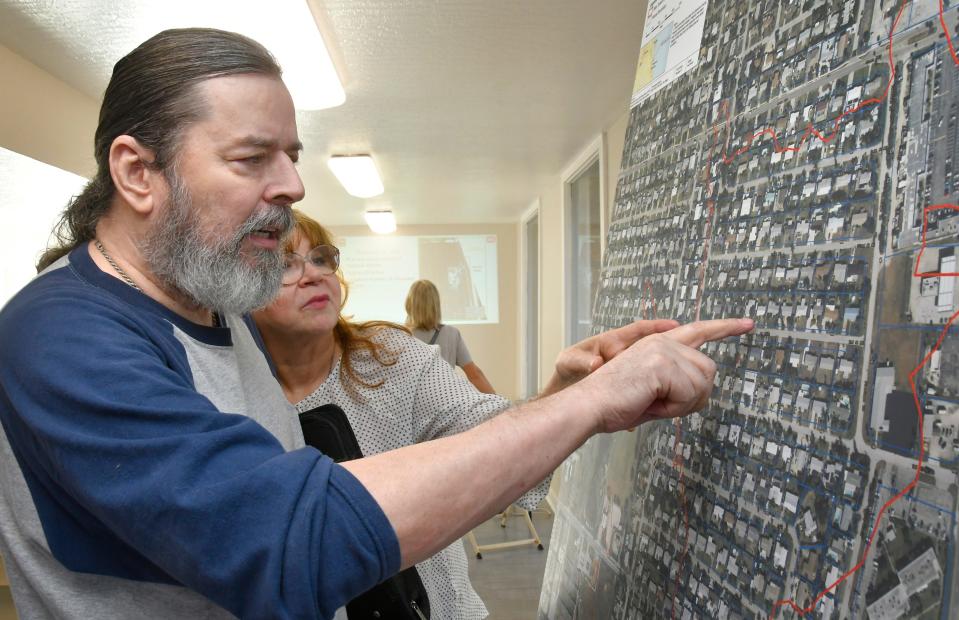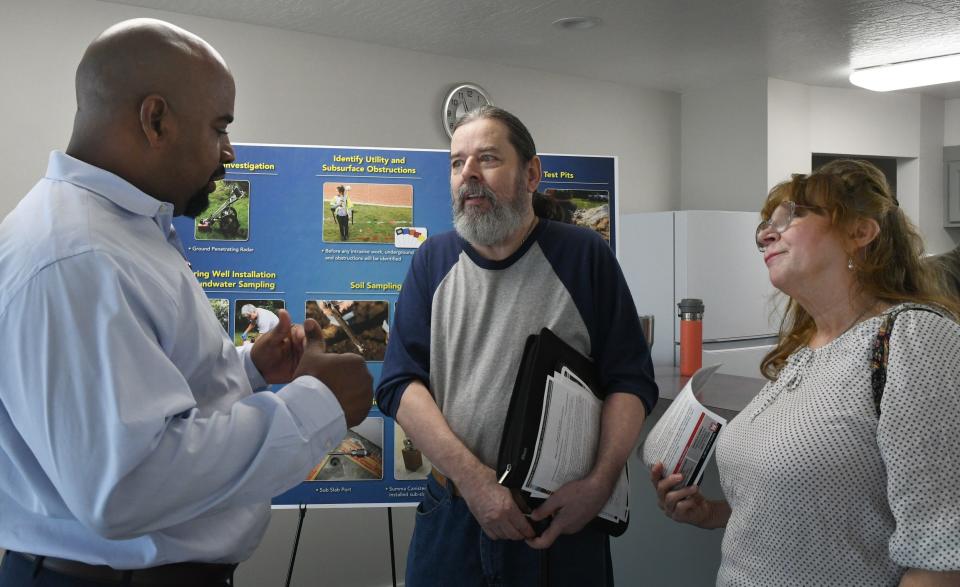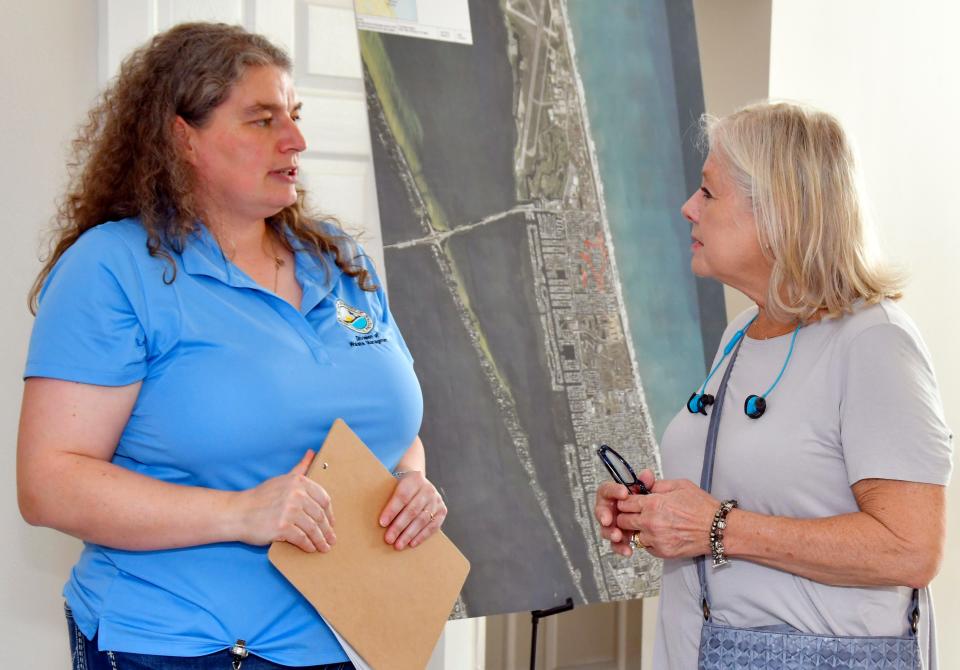Army Corps to start search for military waste in South Patrick Shores
Will and Pat Dixon live smack dab in the middle of what they fear is a waste dump of abandoned military chemicals and hardware.
Their home is in the center of a 52-acre area where workers next week will begin searching for old military waste, some dating back to World War II.
"If there's a ground zero, that's us," Will Dixon, 72, of South Patrick Shores, said Thursday at a U.S. Army Corps of Engineers community meeting at Pelican Beach Park in Satellite Beach.

The Corps was in town to discuss the status of an environmental investigation and pending cleanup of former defense sites just south of Patrick Space Force Base, a military mess that has raised fears of health risks for decades.
Some area residents have long been concerned by what they see as an abnormally high rate of rare cancers and other diseases among those who have lived in the area.
A state report in 2019, found no significant health risk. But a Jacksonville oncologist who graduated from Satellite High, said the state performed an inadequate study.
On Feb. 27, the Corps will begin scanning hundreds of homeowner's yards in the area with ground-penetrating radar, seeking buried objects that could pose health or environmental risk. The area was part of Banana River Naval Air Station during World War II.
This $5.8 million early phase of the project will yield a draft remedial investigation report in the summer of 2024. The purpose of the report is to determine the nature and extent of the military's impacts at the off-base disposal area.
The total cost and exact timelines of the cleanup have yet to be determined. If necessary, a feasibility study would follow and then a proposed cleanup plan, Corps officials said, which would include a public comment period.
Still, the yard scanning comes as a milestone in a decades-long battle by South Patrick Shores residents to get federal and state government to clean up military waste.
Some residents who turned up Thursday expressed relief that government at last appears to be serious about a long-term clean up.
In 1991, after residents brought health concerns to state and federal agencies, studies by those agencies found "no apparent public health hazard, Corps officials said.
At the time, officials said they also failed to find any records that the Navy owned or leased the land.
Then in 2018 debris found buried in residential yards led to requests for another investigation. After that, based on newly found records showing the Navy did use the property, the area became eligible for cleanup under the Corps' Formerly Used Defense Sites (FUDS) program.
The Corps plans to move forward with investigations and cleanups, where property owners have signed "rights-of-entry" to test for groundwater and/or soil contamination.
More than 300 homes sit within the 52-acre area south of Patrick Space Force Base targeted for cleanup.
Some residents fear what dangers a shovel might one day find in their yards, from airplane parts to ordnance or drums of unknown chemicals. While nobody's been injured from an explosion yet, concerns are real. Items dug up over the years have included small practice bombs that lack any explosives, Corps officials said.
To date, 182 of 318 eligible property owners have signed "right-of-entry" forms, allowing the Corps to probe their yards for waste. While the deadline to receive signed rights-of-entry has passed, Corps officials are encouraging all property owners who received and have not yet signed the form to do so as soon as possible. If someone signs the form after fieldwork begins, the Corps says the agency cannot guarantee that property will be investigated.
The agency plans to probe South Patrick Shores yards for any dangerous debris or chemicals left behind before, during and after World War II. Workers will drive in mini-excavators, grab soil samples by hand, and use ground-penetrating radar to survey for metals. If soil or groundwater samples raise suspicions, workers will place small canisters inside homes to test for vapors that might be entering the house from underground.
Pat Deabenderfer has lived several blocks south of Pineda Causeway, outside the boundaries of the current 52-acre cleanup area, for more than four decades. He once found a 50-caliber shell in his yard. He showed up to Thursday's meeting out of curiosity about how so much military waste wound up off base. "I'm interested why they dragged it this far to bury it," Debenderfer said.
William Dixon also once found a 50-caliber bullet and an aluminum piece of an aircraft in his yard on 2nd Street East, where he's lived since 1984. He heard of a neighbor digging up a propeller. Dixon, who walks with a cane, said he has multiple sclerosis but thinks that's unrelated to him living in South Patrick Shores. But two of his three adult children have health issues that make him wonder: one a rare breast cancer and the other a neurological problem, he said.

The Dixons and others recall the frustration in the 1990s when residents raised similar concerns and health and environmental officials failed to take action. "I don't think they gave as much attention to it as they should have. From what I could tell, they just tabled it."
Now, it seems like the Corps is taking the issue much more seriously, William Dixon added.
Some residents have expressed disappointment in recent years at what they say hasn't been aggressive enough testing.
For example, in May 2019, the Florida Department of Health released the results of a more than yearlong investigation of illnesses in the area, concluding no significant public health risks.
At the time, the Jacksonville oncologist who grew up in Brevard and had helped get the state to investigate cancers in the Satellite Beach and Suntree areas, said the state's investigation fell far short of what she'd asked for.
The DOH investigation failed to examine all cancer types, the oncologist and other critics said, or to include hundreds of local cancer cases activists and survivors reported to the health department.
Sandra Sullivan, of South Patrick Shores, has pushed the Corps for years to clean up the contamination near the base, including what's buried in her yard. To further the cause, she joined Patrick Space Force Base's Restoration Board, a panel that advises the military on base-related environmental cleanups.
Her biggest worry is that the testing is set up in a way that could likely miss toxic chemicals soaked into the soil. Some scientists believe that "vapor intrusion" from such chemicals is a major source of indoor air pollution.
"My greatest concern is the volatile chemicals vapor intrusion into homes," Sullivan said via email Friday, noting that vapors into homes were among the highest risk of exposure identified by the Corps and state environmental officials. "Yet that is not tested until the end of the timeline. Dumps are ubiquitous with vapor intrusion into homes," she added. "With higher cancers in our area, prioritizing testing of possible chemical exposures in homes should be the immediate focus. Real-time monitoring is a sound technology."
More:Feds suspect how dumpsite toxins enter Space Coast beachside homes: vapor intrusion
Soil vapor intrusion into homes was the theory that Bob Bowcock — who consults on water contamination issues for environmental activist Erin Brockovich — speculated about during a September 2018 community forum in Satellite Beach hosted by Brockovich. A Corps presentation in August 2021 appeared to validate Bowcock's theory.
At the time, he slammed the military for ignoring vapor intrusion and underplaying health and environmental risks from their past activities on and near bases. "The Department of Defense is a shameful organization that has repeated this practice scores of times from Camp Lejeune to the Aberdeen Proving Grounds. Just as many sites covered up, underreported or not reported at all.
"Landfilled soils, on a sand bar, between a lagoon and the Atlantic Ocean," he said at the time. "It’s as if a giant plunger was forcing toxic air into these homes every time the tide rises. It’s not rocket science … it’s common sense that was intentionally ignored — with purpose — the purpose being, they thought they would get away with it."

Information about the other potential cleanup sites can be accessed at this Corps site.
The U.S. Army Corps of Engineers is preparing to begin the first phase of the Remedial Investigation field work (ground penetrating radar) near Patrick Space Force Base. For information, email FUDS.Florida@usace.army.mil or call 800-710-5184.
Vapor intrusion: Feds suspect how military dumpsite toxins enter Space Coast beachside homes: vapor intrusion
Documents exposed: Key documents exposed military's role in dump site near Patrick Air Force Base
Next steps: Feds lay out next steps in military dumpsite cleanup among Space Coast beachside homes
Jim Waymer is an environment reporter at FLORIDA TODAY. Contact Waymer at 321-261-5903 or jwaymer@floridatoday.com. Or find him on Twitter: @JWayEnviro or on Facebook: www.facebook.com/jim.waymer
This article originally appeared on Florida Today: Army Corps to start search for military waste in South Patrick Shores

